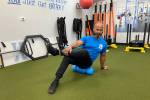GO: Mobility problems don’t have to stop you
Getting a cane, walker or wheelchair is much like when teenagers get their driver’s license.
At least that’s the way Christopher Vito sees it.
Vito, president of the Nevada Adult Day Healthcare Centers, said seniors looking to overcome physical limitations by using a mobility device face many challenges.
But, like a new driver, proper practice and preparation can make for a smooth transition.
"It’s just like driving — when you start driving you go through a driving school or are taught to drive," Vito said. "If you don’t, you’ll probably get lost and get in an accident. That’s why it’s extremely important for seniors to see how to appropriately use a walker and have someone teach them appropriately how to use it."
According to an in-depth mobility study out of Beth Israel Deaconess Medical Center, more than 19 million Americans use a mobility device or have difficulties walking. And that 19 million figure does not include people in institutions or nursing homes. That’s more than 10 percent of the adult population in America.
Mobility issues, along with the risk of falling, are two of the biggest challenges that older people face.
It’s these simple things in life that many able-bodied people may easily take for granted. Sidewalks, stairs and being able to get behind the wheel of a car may seem like inalienable rights for many. But for people with mobility problems, such mundane tasks can be unattainable luxuries.
Joint pain, arthritis, falls and heart disease are just a few of the main reasons why many older adults end up relying on mobility devices.
Mobility problems, whether caused by a disability or just old age, can turn everyday tasks into complicated ordeals. That’s why it’s important for people with mobility issues to understand the devices out there that can aid them in their fight against mobility problems. Whether it’s a cane or a scooter, a walker or a wheelchair, there are many options to help less-than-able bodies navigate around.
The most important thing to remember when seeking a mobility device is to not do it alone, Vito said.
"When seniors are given a cane or walker or wheelchair, they are actually given orders by a physician when a physical therapist determines a cane or walker is needed," Vito said. "Then a physical therapist or home health care company will show them how to use a walker or cane. They don’t just get a walker and start using it."
According to Disabled World, problems with mobility devices are on the rise. In 2008, more than 100,000 Americans were injured while using a wheelchair, cane, walker or scooter. These means of assisted transportation are called mobility devices. The amount of people who have been injured while using mobility devices has doubled in the past 10 years.
It’s not that these devices aren’t safe. Rather, the problem is that people choosing a mobility device often don’t have ample information to help them in their selection. Either they choose the wrong device, or they don’t know how to properly operate the one they do select.
That’s why it’s so important to see a trained professional before using a device. Using a friend’s cane or buying a walker from the store isn’t a good idea. You need to get it professionally adjusted and need practice walking on all types of surfaces.
Vito said practicing on sand, rocks, stairs, inclines and declines can better prepare seniors for mobility problems they may face.
Vito said. "A physical therapist teaches them how to use it appropriately before they actually use it. That goes as well for wheelchairs and so on and so forth."
Proper instruction alone won’t erase all mobility issues senior face. Neither will all the mobility devices in the world. Vito said one of the main reasons falling is such an issue in senior care isn’t because of the mobility devices people use. Rather, it’s because seniors’ lack of strength.
"Falls happen because seniors don’t exercise," Vito said. "If they have a fractured hip then they don’t exercise enough to get their muscles strong enough to stabilize themselves."
A walking stick or a cane is generally for people who are still very mobile except for a minor limitation on one leg or the other. A cane or walking stick should be measured by a professional. Usually, it should come up to about the knuckle on your thumb. If it’s too short or too long, it could do more harm than good. If you also have balance issues, you should opt for a cane with four tips.
A walker is one step up from a cane and should be used if one leg is extremely limited or if there is great pain or limitations in both legs. Like a cane, a walker should be positioned by a medical professional so it is the right height. Walkers are often relied on if a person has a great risk of falling, as a walker might not be stable enough to prevent falls. If you rely on the walker for balance and have to lean on it, a walker with two wheels is best. If you don’t need a walker to help you constantly balance, a four-wheeled walker gives you more freedom.
Here’s a breakdown of some of the most common mobility devices and their uses:
Scooters have boomed in popularity in the past decade and offer a more mobile alternative to the wheelchair. A scooter should be used by people whose lower body cannot hold up even using a walker, but who have more mobility in their upper body. Also, a scooter can be used if people have limited use of their lower body but their legs need a break.
Wheelchairs are reserved for those with the most mobility problems. Someone who loses complete function of a lower limb will benefit from using a wheelchair. Because of its size and bulkiness, though, home modifications or a caregiver are often needed for a person with a wheelchair.
While a mobility device can be a godsend as far as maneuverability, it can be damaging to an older person’s self-esteem or sense of freedom. With that in mind, a person greatly affected by using a mobility device may want to turn to a support group. In rare cases, medication can help if a person is depressed or overly agitated because of the newfound equipment. Also, finding a full- or part-time caregiver might be needed depending on the severity of an injury or condition. For example, if your parent is now using a wheelchair because of a stroke but wants to stay at home, a caregiver may be needed to help that parent get around the house, shower, dress or eat.
Also, the decision you make greatly impacts your at-home situation. For example, if you or a parent with mobility issues has started using a wheelchair and wants to remain at home, changes must be made to the house. Stairs must be replaced by ramps or accompanied by lifts. Sinks and counters might have to be lowered and doors and hallways may have to be widened.























